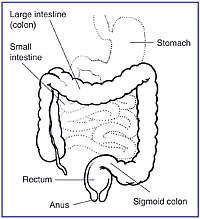
Digestion & Digestive health - Crohn's disease
Crohn’s disease
Crohn’s disease also known as inflammatory bowel disease or IBD, is an ongoing disorder that causes inflammation of the digestive tract, also referred to as the gastrointestinal (GI) tract. Crohn’s disease can affect any area of the GI tract, from the mouth to the anus, but it most commonly affects the lower part of the small intestine, called the ileum. The swelling extends deep into the lining of the affected organ. The swelling can cause pain and can make the intestines empty frequently, resulting in diarrhea.Crohn's disease develops where the small and large intestines meet and usually causes all layers of the intestinal wall to become sore, inflamed, and swollen. Crohn's disease can affect any part of the digestive tract, including the mouth, esophagus, stomach, small intestines, large intestines, and anus but it most commonly affects the lower part of the small intestine, called the ileum. The swelling extends deep into the lining of the affected organ. The swelling can cause pain and can make the intestines empty frequently, resulting in diarrhea. .Ulcerative colitis inflames only the inner lining of all or part of the colon and rectum. Sometimes, only the rectum is affected. In both inflammation may stick around for many years, flaring up over and over again.Crohn’s disease is an ongoing disorder that causes inflammation of the digestive tract, also referred to as the gastrointestinal (GI) tract.
Crohn’s disease is an inflammatory bowel disease, the general name for diseases that cause swelling in the intestines. Because the symptoms of Crohn’s disease are similar to other intestinal disorders, such as irritable bowel syndrome and ulcerative colitis, it can be difficult to diagnose. Ulcerative colitis causes inflammation and ulcers in the top layer of the lining of the large intestine. In Crohn’s disease, all layers of the intestine may be involved, and normal healthy bowel can be found between sections of diseased bowel.
Crohn’s disease affects men and women equally and seems to run in some families. About 20 percent of people with Crohn’s disease have a blood relative with some form of inflammatory bowel disease, most often a brother or sister and sometimes a parent or child. Crohn’s disease can occur in people of all age groups, but it is more often diagnosed in people between the ages of 20 and 30. People of Jewish heritage have an increased risk of developing Crohn’s disease, and African Americans are at decreased risk for developing Crohn’s disease.Crohn’s disease may also be called ileitis or enteritis.
The most common symptoms of Crohn’s disease are abdominal pain, often in the lower right area, and diarrhea. Rectal bleeding, weight loss, arthritis, skin problems, and fever may also occur. Bleeding may be serious and persistent, leading to anemia. Children with Crohn’s disease may suffer delayed development and stunted growth. The range and severity of symptoms varies.
Read More AboutCauses, Symptoms, Diagnosis & Treatment of Crohn's Disease
Articles online on Crohn's Disease and related Digestive Disorders
- Ulcerative Colitis and Crohn's Disease
- Crohn's Disease and Male Genitalia
- Colonoscopy
- Advances in Digestive Diseases
- Alternative Medicine in Digestive Diseases